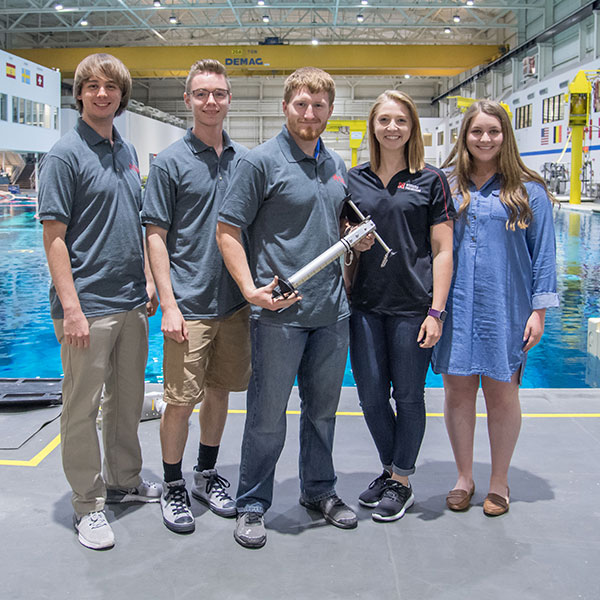Calendar Icon
Jul 06, 2017
Person Bust Icon
By Karl Vogel
![]() RSS
Submit a Story
RSS
Submit a Story

In designing a device that could help anchor equipment and tether astronauts to the terrain of the moon or another planet, expansion became a key component of the University of Nebraska-Lincoln’s Air and Space Research Team’s project for the annual NASA Micro-g NExT Challenge.
The team spent more than six months designing this anchoring device.
After many ideas and iterations, Borcyk said, the team settled on an anchor with arms that are screwed, much like an auger, into a layer of regolith (loose material that covers solid rock).
Once at a desired depth, the handles are unlocked and spun. The ends then splay outward and a balloon-like device is deployed, creating more surface area for the anchor and with it more displaced volume that keeps the vehicle anchored.
In late May, the team took five engineering students – Borcyk and Claire Ashley, both seniors in mechanical engineering, club president Allison Porter, a senior in biological systems engineering; Will Fleener, a junior in computer engineering; and Andrew Mason, a sophomore in chemical engineering – to NASA’s Johnson Space Center in Houston to test the anchor.
Despite suffering an equipment setback, the team’s design tested well above NASA specifications, Borcyk said.
“We were unable to get one of our metal parts fully machined – it needed some small welds and we didn’t account for that – so we had to get it 3-D printed in plastic,” Borcyk said. “When we went to do our own testing the week before, the part sheared off.”
The ASR team retrofitted the bit to the device’s handles and tested the device, hoping to meet the required minimum of anchoring for 20 pounds of force.
“We capped out their force gauge at 60 pounds,” Borcyk said with a smile. “We got to see the other teams’ designs, and most of them had some sort of corkscrewing component, but everyone had a different approach to how you keep it in the ground. Our bit was seemingly very, very effective, and that was cool.”
Having a small group of students working on the project – Borcyk said ASR had “five or six” members who were active the entire year – presented challenges for the team in generating ideas for the device.
“We have more mechanical engineers than any other major, and all of us learn the same things in all our classes and we tend to think more linearly,” said Borcyk. “In engineering core classes, we have learned that diversity of mind-set can lead to great ideas.”
And with outreach a part of the NASA project, previous ASR teams have gone into local middle schools and high schools and made presentations to young students about their group and STEM fields.
This year, however, ASR wants to its reach at home by recruiting across the university. This, Borcyk said, would increase both the membership and the number of projects the organization could accept.
For the Micro-g Challenge, Borcyk said, it would allow ASR to continue its tradition of experienced team members stepping back and taking on mentoring roles as younger students take charge of the project. In addition to again recruiting at the Engineering Club Fair, Borcyk said the team is considering trying to get table space at the annual Big Red Welcome event, which will be held on Aug. 20, the day before Fall Semester classes begin.
“We are a small club right now. We looked into different projects, but because of the limited participation in our club we decided to pursue only one,” Borcyk said. “Expanding the club, making things more structured and formal, is the intent. The new recruits would have fresh ideas and not be biased based on what they’ve already seen from previous years.
“Having business majors or teachers or biologists come in and throw ideas off of us would be great. That would be big for us as a club.”
Submit a Story




